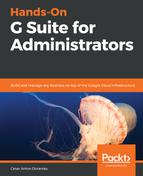In this chapter, we learned how to set up an organization's Calendar, starting with sharing events and availability between members and the public, setting up resources to make choosing the right location easier for users, and making and highlighting the most and least used resources. We also looked at how to integrate Calendar and Microsoft Exchange.
Now you know how to use Google Groups to group members of an organization and route messages, such as support requests, to the right people in the organization. You can now set up a dedicated social network so that your organization can help its members collaborate internally, or with their customers and partners.
In this chapter, you also got familiar with how to set up Google Hangouts Chat and Meet as an organization, along with how collaborators can use it to improve their real-time communication, while being aware of its limits.
Finally, we walked through Google Drive's configurations. We learned how to set up the configuration options, migrate documents between accounts, transfer ownership, and how to enable or block the offline features of the service. With Google Drive, members of an organization can create, edit, store, share, and collaborate on documents, without having to worry about losing or compromising information.
By now, you can create and set up the main components of G Suite for Business for a new domain. Sometimes, however, you will be migrating a team from a previous system, so in Chapter 4, Moving on with Data Migration Systems, we will focus on the details of dealing with legacy services.
